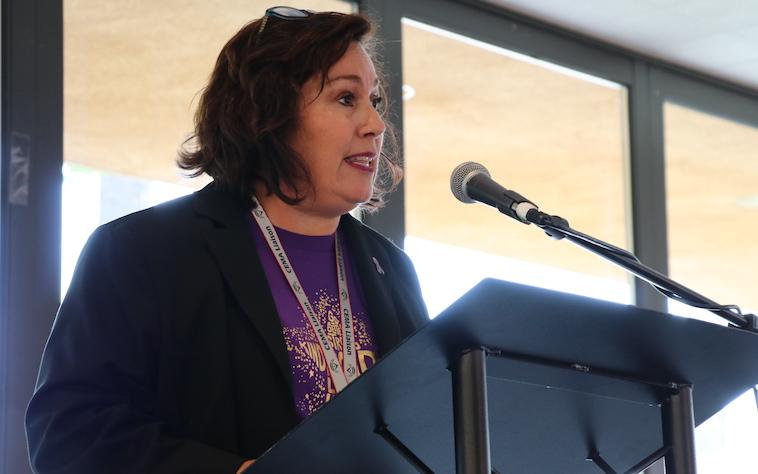
Disrupting the Cycle of Gender-Based Violence
What happens when we must shelter-in-place, but home is not safe?
It’s the critical question Carla Collins ’91 has been helping Santa Clara County address since mid-March, when the county was the first in the nation to declare shelter-in-place public orders.
As manager of its new Office of Gender-Based Violence Prevention, which opened last September, Collins was already focused on developing an updated, countywide strategy to tackle intimate partner violence, human trafficking, and sexual assault.
Suddenly, Collins—whose aunt was the county’s 47th COVID-19 fatality—had to quickly pivot with her three-and-a-half-member staff and one volunteer. Along with domestic violence shelter agencies, the county’s Office of Supportive Housing, and the City of San Jose, they devised ways to provide safe, emergency shelter to those fleeing violence during the pandemic.
“Horrible things are happening in our county and we need to respond strategically,’’ says Collins. “Many victims need emergency and transition housing, and other survivor support as well. The county is committed to doing that.”
That means if shelters—which due to COVID-19 limit the number of people they can serve—are unable to accommodate them, these victims are moved to hotels and motels. If their children are students, the school districts, county, and City of San Jose are providing laptops, iPads, Chromebooks, and hot spots for the kids to do their work in safety, remotely.
Immediately after the shelter-in-place took effect, Collins’ office and its community resources partners also began working to ensure that virtual, multi-lingual services would be available to victims, many of whom speak a language other than English.
“We are a diverse community. It’s not just like one program fits all,” says Collins, whose office launched it first virtual awareness campaign in April—timed to Sexual Assault Awareness Month—along with enhanced information available through @SCCEndViolence via Facebook, Twitter, and Instagram.
Victims offered remote assistance, “safe chats”
The social media platforms offer victims and their families everything from phone numbers for remote assistance, options for live “safe chats,” instructions about accessing and filling out restraining orders, emergency custody, visitation requests, and emergency guardianship, among other free or low-cost services.
Since spring, Collins says Facebook Live sessions on county briefings related to these kinds of community resources have recorded at least 13,600 views in English, 3,900 impressions in Spanish, and 1.2 million impressions in Vietnamese.
The steep numbers don’t surprise her, nor do the grim statistics underlying them. Santa Clara County’s five local domestic violence agencies annually receive more than 20,000 hotline calls; deliver services to more than 6,000 adults and children, and provide shelter or housing to at least 500 adults and children.
Every year, Collins says the Office of the District Attorney reviews more than 5,000 domestic violence-related cases. Victims fleeing violence in their homes often end up living on the streets, further contributing to the county’s homeless population.
To anyone else, perhaps, the problem might seem overwhelming, unbearable, even impossible to solve.
But not to Collins.
“My faith is a big part of my social justice work,” she says. “And it’s a big part of what makes me such an optimist, because I know we can do better.”
A healing process at SCU
Collins’ journey to help those who often cannot escape their circumstances began years ago during her own healing process, one that led her to embrace a career in social justice.
In July 1987, the San Jose native who studied at St. Lawrence Academy in Santa Clara had received a scholarship to attend New York University. But her plan to move to the East Coast ended abruptly when her father died a month after her high school graduation.
“It was devastating to my mother and me,” recalls Collins, an only child who deferred her dream as the first in her family to attend a four-year college, to stay with her mother.
A family friend’s suggestion to quickly apply to SCU was fortuitous; if she took a part-time campus job, the University said it would honor her scholarship. “It was part of my healing,” recalls the philosophy major. “I found this incredible community that first year, and it kept me going. It was like New York was completely forgotten.”
Fast-forward to an entry-level job at the county, marriage, three children, and almost two decades working at the county’s Office of Women’s Policy before she was selected to lead the Office of Gender-Based Violence Prevention.
With an annual budget of $12 million, Collins’ office has spent much of the last year establishing a system for better data-driven outcomes that centers survivors and their needs. She helped develop a flagship training program for county partners and community stakeholders, and re-imagined the way contracts are administered with her office, to increase flexibility and better meet victims’ needs.
In short, says a grateful Collins, “I ended up where I was meant to be.”